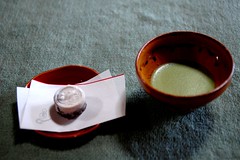![]() photo credit: Yuki Yaginuma
photo credit: Yuki Yaginuma  Japanese tea is delicate, mild, and can be served hot or cold, depending on the season. Tea has been enjoyed for centuries in Japan and is an important part of the culture. Sado, tea ceremony, is dedicated to the way of serving and preparing green tea. According to the Ippodo Tea Company, which I have been told is the most famous tea company in Kyoto and one who has been specializing in fine tea since 1846, the secret to making delicious tea lies in three elements: tea leaves, water, and time. The amount of tea leaves, the temperature of the water, and how long you wait until you pour the tea all have an effect on the taste of the tea. Also, the best part of the tea is in the bottom of the teapot, so it’s best to make sure you have poured out all the tea that was in the pot.
Japanese tea is delicate, mild, and can be served hot or cold, depending on the season. Tea has been enjoyed for centuries in Japan and is an important part of the culture. Sado, tea ceremony, is dedicated to the way of serving and preparing green tea. According to the Ippodo Tea Company, which I have been told is the most famous tea company in Kyoto and one who has been specializing in fine tea since 1846, the secret to making delicious tea lies in three elements: tea leaves, water, and time. The amount of tea leaves, the temperature of the water, and how long you wait until you pour the tea all have an effect on the taste of the tea. Also, the best part of the tea is in the bottom of the teapot, so it’s best to make sure you have poured out all the tea that was in the pot.
The most well known Japanese tea is green tea of course, but matcha comes in two varieties, as a thicker koicha, or as a thinner usucha. Usucha is what we often buy at the convenience store or from vending machines on a hot summer day. In order to prepare matcha, we need three things: a bamboo tea whisk (chasen), a matcha tea bowl (matcha-chawan), and a tea ladle (chashaku). We need 1 to 1 ½ heaping tea ladles of matcha powder and about 1/3 of a tea bowl of water which should be at 80 degrees Celsius.
To brew matcha, we must pour the matcha powder into a tea bowl. Second, we gently pour the hot water over the matcha powder. Next, using a quick back and forth motion, we whisk the mixture until it smooth and then serve it in the tea bowl. That’s it. Matcha powder does not actually dissolve into the water so it’s best to drink the matcha before the particles settle at the bottom of the tea bowl.
Matcha is best served with traditional Japanese sweets such as dango, daifuku, or zenzai because the bitter taste of it is gently balanced by the mildly sweet taste of the sweets. Some other teas which are not to be forgotten are gyokuro, sencha, and bancha tea. Gyokuro tea is a very mellow and sweet tea and can be served hot or cold. Sencha is an everyday green tea, and bancha is a course-leaf tea which comes in three varieties: yanagi, hojicha, and genmaicha. Yanagi tea is a course-leaf tea, hojicha is a roasted yanagi, and genmaicha is a blend of yanagi and roasted rice. We often see genmaicha translated into English as brown rice tea.
Depending on the weather, you can drink any of these teas cold (except hojicha because it is a roasted tea). To make cold tea, just put the leaves in cold water instead of hot water and wait for the leaves to unravel inside the teapot. Of course, we have all heard that drinking tea is good for our health, especially green tea. The reason for this lies in the fact that green tea is rich in catechin polyphenols, particularly one called EGCG.
EGCG is a powerful antioxidant and has been shown to inhibit the growth of cancer cells. It also lowers cholesterol, helps arthritis, increases immune function, slows or stops infection, helps burn calories, prevents tooth decay and food poisoning, and reduces skin inflammation. In fact, green tea is to Japan what red wine is to France. Research has proven that although the French have a rich diet high in fat, they have a low rate of heart disease. And although 75 percent of Japanese men are smokers, they also have a low rate of heart disease. Research has also shown that EGCG in green tea is twice as strong as resveratrol, which is the antioxidant found in red wine.
However, not all teas are created equal. Green, oolong, and other black teas all come from the same leaf. The reason green tea keeps the EGCG is because its leaves are steamed, not fermented like the other teas. So while all teas have some health benefits, green is the way to go. Now if that doesn’t convince you to start drinking green tea, I don’t know what will. Go green.

